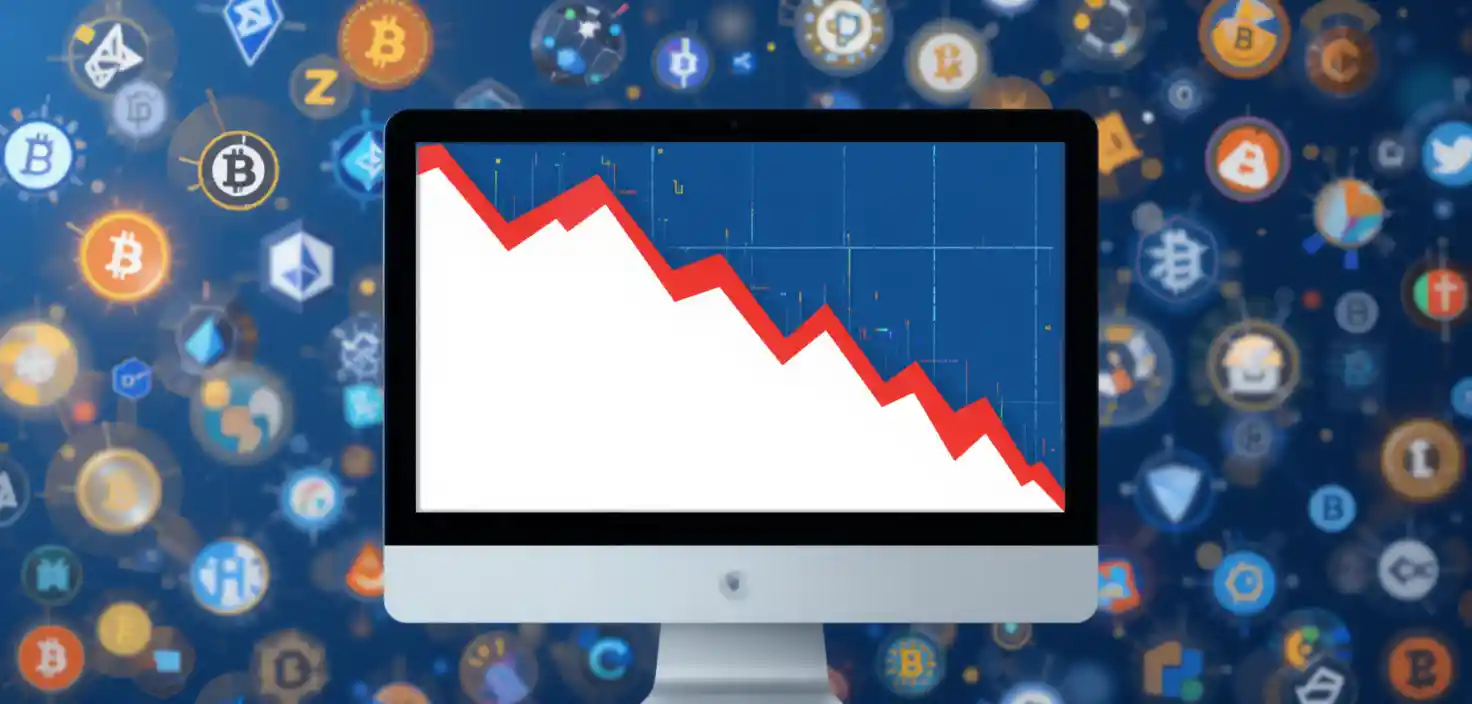Cryptocurrency has captured the imagination of investors and tech enthusiasts alike, with its meteoric rise making many people millionaires and sparking a global digital revolution. But now, the markets are experiencing a significant downturn. If you’re wondering why crypto is crashing, you’re not alone. The sudden volatility of cryptocurrencies, once seen as a secure alternative to traditional investments, is raising concerns for both new and seasoned investors. In this post, we’ll explore the key factors behind this crypto crash and provide insights into what could happen next.
The Initial Buzz: The Rise of Cryptocurrencies
Before diving into why crypto is crashing, let’s take a quick look at why it surged in the first place. Cryptocurrencies like Bitcoin, Ethereum, and newer altcoins gained enormous traction over the last decade. They offered decentralized, borderless financial systems, attracting millions of investors seeking privacy, lower fees, and independence from traditional banking systems.
Over time, cryptos gained a reputation as a “store of value,” even drawing comparisons to gold. Institutions began to pour money into the market, and retail investors joined the wave, creating massive bullish momentum. The hype around decentralized finance (DeFi), Non-Fungible Tokens (NFTs), and blockchain technology gave even more fuel to this explosive growth.
However, as we’re seeing today, the market’s rapid rise was followed by an equally rapid decline. But why is crypto crashing now?
Regulatory Concerns and Government Crackdowns
One of the most significant factors contributing to the recent crypto crash is the tightening of government regulations. Cryptocurrencies, once celebrated for their ability to operate outside government control, have now drawn the attention of regulators worldwide.
For example, China made headlines by cracking down on cryptocurrency mining, which significantly impacted Bitcoin’s value. Countries like India have also discussed possible bans on crypto trading, and the U.S. government has started to explore the idea of imposing stricter regulations on crypto exchanges and wallets.
The uncertainty surrounding the legal status of crypto in many countries is driving fear in the market. Investors are worried that further crackdowns or regulations could restrict or even outlaw cryptocurrency trading, leading to a loss of confidence in digital currencies. As a result, many are choosing to exit the market or hold back on new investments, contributing to the downturn.
Rising Inflation and Interest Rates
Inflation has been a hot topic in the U.S., with the Federal Reserve raising interest rates to combat the rising cost of goods and services. Typically, cryptocurrencies are seen as a hedge against inflation, but the reality is more complex. When the cost of living increases and interest rates rise, investors tend to move away from riskier assets like crypto in favor of safer, more stable investments, such as government bonds or stocks.

As the U.S. dollar strengthens due to higher interest rates, cryptocurrencies like Bitcoin and Ethereum face downward pressure. Investors are pulling their money from speculative assets to reduce exposure to the volatility inherent in the crypto market. This shift in investment behavior is a major factor in why crypto is crashing right now.
Market Manipulation and Speculation
Cryptocurrency markets have long been criticized for being susceptible to market manipulation. Whale traders (large investors or entities with significant holdings in crypto) can easily influence prices by making large trades. The relatively low liquidity of crypto markets, especially with smaller altcoins, makes them more prone to sudden, sharp price movements.
Additionally, speculative trading plays a significant role in crypto’s volatility. Many investors buy and sell based on trends, hype, or rumors rather than on solid fundamentals. This speculative behavior can lead to inflated prices, which eventually come crashing down when reality sets in. When the market hits a tipping point, the sell-offs begin, and prices drop precipitously.
Environmental Concerns and Energy Consumption
A key issue that has emerged in the crypto market is the environmental impact of mining operations, particularly Bitcoin. Bitcoin’s proof-of-work consensus mechanism requires vast amounts of computational power, which in turn uses an enormous amount of electricity. Environmental groups have raised concerns about the ecological footprint of cryptocurrency mining, and several companies, governments, and even investors are starting to reconsider their involvement in crypto due to these concerns.
In 2021, Elon Musk’s decision to suspend Tesla’s acceptance of Bitcoin for purchases, citing environmental concerns, sent shockwaves through the market. While not the sole cause, the ongoing debate over crypto’s environmental impact is part of the broader narrative of why crypto is crashing.
Technological Challenges and Network Issues
While the technology behind cryptocurrencies is innovative, it is not without its challenges. For instance, scalability remains a significant issue, particularly for Bitcoin and Ethereum, which struggle with high transaction fees and slow processing times during periods of heavy demand.
Ethereum has been working on transitioning to a proof-of-stake model to address these concerns, but the transition has been slow. Meanwhile, competitors like Solana and Cardano have emerged, touting faster and cheaper transactions. However, these newer networks face their own hurdles, and the uncertainty surrounding the long-term sustainability of these platforms adds to investor anxiety.
Additionally, the threat of hacks and cyberattacks on cryptocurrency exchanges and wallets adds another layer of risk to the market. These issues can quickly erode investor confidence, making the volatility of the crypto market even more pronounced.
The Impact of Global Events and Market Sentiment
Global events, such as the ongoing pandemic, political instability, and market fluctuations, significantly impact the value of cryptocurrencies. In times of uncertainty, investors tend to flock to safe-haven assets, such as gold or the U.S. dollar, which causes speculative assets like crypto to take a hit.
The overall market sentiment also plays a crucial role. When positive news emerges, such as adoption by major corporations or favorable government regulations, crypto prices can skyrocket. However, the opposite is true when bad news spreads—whether it’s a market crash, exchange hack, or negative regulation.
Psychology of the Market: Fear, Uncertainty, and Doubt (FUD)
The psychological factors behind why crypto is crashing are also important to consider. In the crypto world, rumors, media coverage, and sentiment can lead to “Fear, Uncertainty, and Doubt” (FUD), which can trigger mass sell-offs. When people believe the market is going to crash, they often panic and sell their holdings, which only accelerates the decline.

This fear-driven behavior has created a cycle of volatility in the market. The more FUD spreads, the more prices fall, and the more investors panic and sell.
Frequently Asked Questions
What are the main reasons behind the current crypto crash?
The current crypto crash can be attributed to several factors, including regulatory concerns, rising inflation and interest rates, market manipulation, environmental issues related to mining, technological challenges, and overall market sentiment. The combination of these factors has led to a decrease in investor confidence and a significant decline in cryptocurrency prices.
Is this the end of cryptocurrencies?
While the crypto market is currently facing a downturn, it’s important to note that cryptocurrency has always been volatile. It has experienced ups and downs in the past and could recover over time. The technology behind crypto remains strong, but its short-term volatility makes it a high-risk investment.
Are government regulations contributing to the crash?
Yes, government crackdowns and the tightening of regulations are significant contributors to the current crash. Many countries are looking to impose stricter rules on cryptocurrency exchanges, mining operations, and even banning crypto entirely. This has caused fear and uncertainty among investors, leading to a sell-off.
How do rising inflation and interest rates affect the crypto market?
Rising inflation and interest rates make traditional, low-risk investments more attractive. As central banks raise interest rates to combat inflation, investors tend to move away from speculative assets like crypto and seek stability in bonds or stocks. This shift in investment behavior has put downward pressure on cryptocurrencies.
What role does market manipulation play in crypto crashes?
Market manipulation, particularly by large holders known as “whales,” is a significant factor in crypto’s volatility. These whales can influence prices by making large trades, creating sudden price spikes or drops. This type of market manipulation can lead to sharp downturns, especially in smaller, less liquid cryptocurrencies.
Why are environmental concerns affecting the crypto market?
Cryptocurrency mining, especially Bitcoin, requires substantial computational power and energy consumption, leading to concerns over its environmental impact. Critics argue that the energy used for mining contributes to climate change. These concerns have caused some investors and companies to reconsider their involvement in crypto, further contributing to the market’s downturn.
Can technological issues lead to the decline of crypto?
Yes, scalability and network issues have plagued several major cryptocurrencies, including Bitcoin and Ethereum. Slow transaction speeds, high fees, and network congestion can deter users and investors, contributing to the market’s volatility. Although some newer cryptocurrencies aim to address these issues, the overall technological uncertainty impacts investor confidence.
How does global economic instability affect crypto prices?
Global economic instability, such as political tensions, market crashes, or health crises like the pandemic, often drives investors toward safer assets like gold and the U.S. dollar. During such times, cryptocurrencies, which are considered speculative and volatile, tend to suffer as investors pull out their money to mitigate risk.
What is the impact of media coverage and public sentiment on crypto crashes?
Media coverage and public sentiment can greatly affect crypto prices. Negative news or widespread fear, uncertainty, and doubt (FUD) can cause mass panic selling, further driving down prices. Since crypto markets are highly sentiment-driven, public perception can significantly influence price movements.
Is it safe to invest in cryptocurrencies right now?
Investing in cryptocurrencies always carries a level of risk due to their inherent volatility. With the current downturn, it’s essential for investors to carefully assess their risk tolerance and investment goals before deciding to enter or remain in the market. Staying informed and being prepared for price fluctuations is crucial when dealing with such a volatile asset.
Conclusion
While the current crash has many wondering why crypto is crashing, it’s essential to remember that the crypto market has always been volatile. Its history is filled with boom-and-bust cycles, and it’s likely that the market will recover in time. However, investors must remain cautious and informed as they navigate this unpredictable landscape.
If you’re considering investing in crypto or are already holding digital assets, it’s important to stay up-to-date on the latest news, understand the risks involved, and make informed decisions based on your financial goals and risk tolerance. Cryptocurrencies may be facing a downturn now, but they remain an exciting, evolving space that could present future opportunities.






